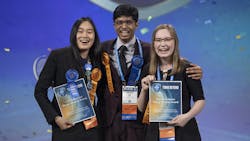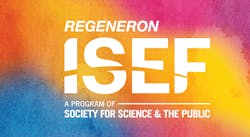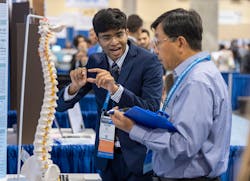Regeneron Sponsors International Science and Engineering Fair
The Intel International Science and Engineering Fair (ISEF) is no more. ISEF is now known as the Regeneron International Science and Engineering Fair (Fig. 1). Regeneron Pharmaceuticals, the named sponsor for ISEF, had earlier picked up the mantel of the Science Talent Search (STS), which was also an Intel-sponsored competition. Intel supported these competitions for over 20 years.
The Society for Science and the Public (SSP) runs these competitions as well as the Broadcom Masters competition for middle-school students. ISEF is for students in grade nine through twelve.
I will be taking the winners of the 2020 Mercer Science and Engineering Fair (MSEF) competition to Anaheim, Calif. the week of May 10th for the 2020 Regeneron ISEF competition. It’s one of hundreds of regional competitions that feed into ISEF. The 2019 competition was host to over 1800 students.
The top winner in 2019 was Krithik Ramesh of Greenwood Village, Colo. (Fig. 2). He received the Gordon E. Moore Award for his project that encompassed augmented reality, machine learning, and computer vision to help orthopedic surgeons achieve greater accuracy for screw placement during spinal surgery.
If you’re looking for top talent in science and engineering, then ISEF is the place to start. Many of these student projects are on par with those done by graduate students at top universities. Some may be using duct tape, baling wire, and 3D image sensors to implement prototypes of augmented-reality applications, but they get the job done. This also highlights the determination and creativity possessed by these students.
It was great news when Regeneron took over the top spot for ISEF, but it’s just one of many sponsors. Challenges remain at the local and regional level, though. It’s important to get everyone involved—not just for sponsorship, but with support for students, judging, and so on. We continue to find it difficult to round up a sufficient number of judges for MSEF. Even getting students to participate in the fair isn’t an easy chore, as many schools don’t even let them know about local competitions.
I’m always encouraging scientists and engineers to become involved in their local fairs. Judging takes very little time and is very rewarding to students and judges. It’s surprising how many espouse STEM education but don’t have a day to help out. We’re lucky to have an active team that tries to increase participation of students, judges, and sponsors. Still, we can use help from the technology and educational arenas as well.
Finding local competitions isn’t hard, and for ISEF-affiliated fairs, it’s as easy as checking the list of fairs on the SSP website. A host of other competitions can use your help, too, such as the FIRST Robotics competition, the Vex Robotics competition, and the Junior Science and Humanities Symposia (JSHS).
STEM education is important and schools are highlighting it, but getting involved with competitions will give students an opportunity to highlight their work.
About the Author
William G. Wong
Senior Content Director - Electronic Design and Microwaves & RF
I am Editor of Electronic Design focusing on embedded, software, and systems. As Senior Content Director, I also manage Microwaves & RF and I work with a great team of editors to provide engineers, programmers, developers and technical managers with interesting and useful articles and videos on a regular basis. Check out our free newsletters to see the latest content.
You can send press releases for new products for possible coverage on the website. I am also interested in receiving contributed articles for publishing on our website. Use our template and send to me along with a signed release form.
Check out my blog, AltEmbedded on Electronic Design, as well as his latest articles on this site that are listed below.
You can visit my social media via these links:
- AltEmbedded on Electronic Design
- Bill Wong on Facebook
- @AltEmbedded on Twitter
- Bill Wong on LinkedIn
I earned a Bachelor of Electrical Engineering at the Georgia Institute of Technology and a Masters in Computer Science from Rutgers University. I still do a bit of programming using everything from C and C++ to Rust and Ada/SPARK. I do a bit of PHP programming for Drupal websites. I have posted a few Drupal modules.
I still get a hand on software and electronic hardware. Some of this can be found on our Kit Close-Up video series. You can also see me on many of our TechXchange Talk videos. I am interested in a range of projects from robotics to artificial intelligence.



